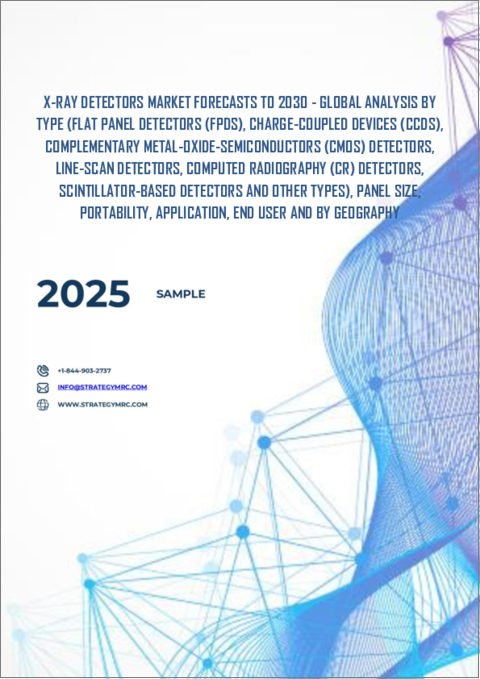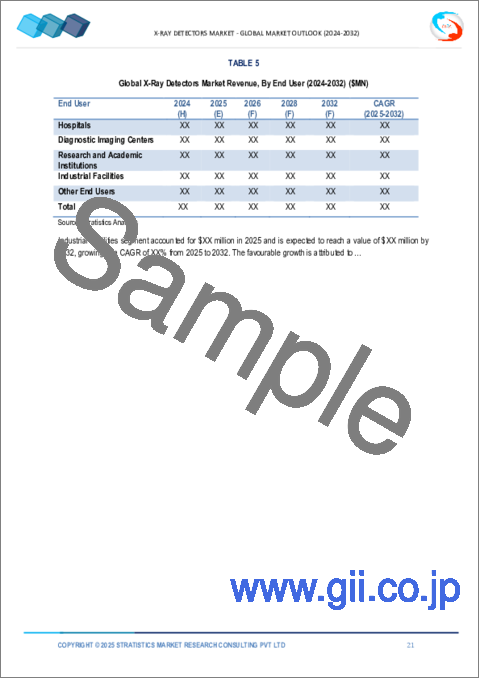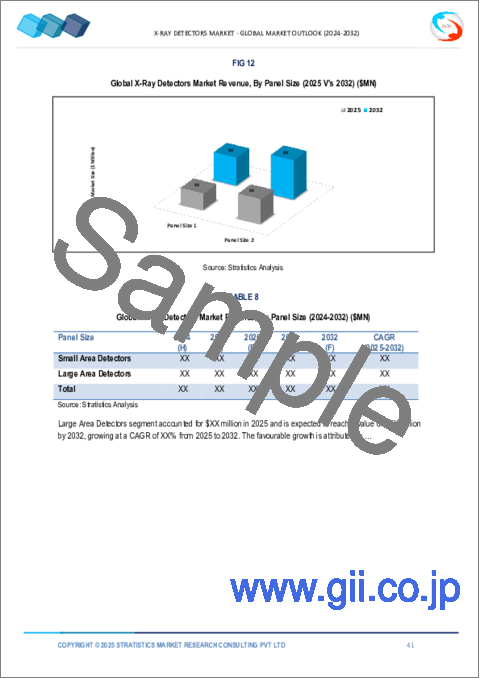|
|
市場調査レポート
商品コード
1617183
X線検出器市場の2030年までの予測:タイプ別、パネルサイズ別、携帯性別、用途別、エンドユーザー別、地域別の世界分析X-Ray Detectors Market Forecasts to 2030 - Global Analysis By Type, Panel Size, Portability, Application, End User and By Geography |
||||||
カスタマイズ可能
|
|||||||
| X線検出器市場の2030年までの予測:タイプ別、パネルサイズ別、携帯性別、用途別、エンドユーザー別、地域別の世界分析 |
|
出版日: 2024年12月11日
発行: Stratistics Market Research Consulting
ページ情報: 英文 200+ Pages
納期: 2~3営業日
|
全表示
- 概要
- 図表
- 目次
Stratistics MRCによると、X線検出器の世界市場は2024年に33億5,000万米ドルを占め、予測期間中のCAGRは7.2%で成長し、2030年には48億5,000万米ドルに達する見込みです。
X線検出器は、X線放射を捕捉・測定し、画像化または分析用の電子信号に変換するために使用される装置です。X線検出器は、医療用イメージング、セキュリティ・スクリーニング、工業用検査など、さまざまな分野で不可欠です。X線が物体を通過し、センサー材料と相互作用する際に放出されるエネルギーを検出することで機能します。X線検出器は、多様な用途において診断能力を高め、安全性を確保するために不可欠です。
ルイジアナ州立大学健康科学センターの放射線科医による分析によると、ある胸部X線検査は非常に特異的で(96.6%)、83.3%という高い陽性適中率を示しています。
慢性疾患と病状の増加
がん、心血管疾患、骨疾患などの慢性疾患や病状の増加は、発見、モニタリング、治療のために定期的な画像診断を必要とします。X線は、骨、組織、臓器の健康状態に関する重要な洞察を提供し、これらの疾患の早期診断と効果的な管理を可能にします。そのため、ヘルスケア施設では最先端のX線システムが採用され、市場の拡大に拍車がかかるとともに、画像品質と患者の予後を改善するための検出器技術の革新が促されています。
技術的な複雑さ
X線検出器、特に高度なデジタル検出器やフラットパネル検出器には、半導体材料、画像処理アルゴリズム、ヘルスケアITシステムとの統合などの複雑な技術が関わっています。こうした技術的な複雑さは、オペレーターやメンテナンス担当者に専門的な知識やトレーニングを必要とするため、特にリソースや専門知識が限られている地域では、導入の障壁となりうる。こうした要因がコストを押し上げ、小規模なヘルスケア施設では最新システムの導入が困難となり、市場成長の妨げとなっています。
放射線被曝の最小化
フラットパネル型検出器などの最新のデジタルX線検出器は、従来のシステムと比較して放射線被ばく量を抑えながら高品質の画像を提供します。このため、患者やヘルスケア従事者の健康リスクが低減され、放射線の過剰被ばくに対する懸念が解消されます。放射線の安全性に対する意識が高まるにつれ、ヘルスケア施設では画像の鮮明度の向上と放射線の低減の両方を実現する先進的な検出器の採用が進んでおり、市場の成長をさらに後押しするとともに、検出器技術の革新を促進しています。
陳腐化のリスク
X線検出器の陳腐化リスクは、技術の急速な進歩により、機能強化、高画質化、低被曝化を実現した新機種が次々と登場していることに起因します。その結果、古いシステムはすぐに時代遅れになり、頻繁なアップグレードが必要になります。アップデートが常に必要となるため、特に小規模の施設や低所得地域では経済的な負担が大きくなり、市場の普及が妨げられ、市場全体の成長が鈍化する可能性があります。
COVID-19の影響
COVID-19の大流行はX線検出器市場に大きな影響を与え、特にCOVID-19に関連する肺疾患の診断に使用される医療用画像処理システムの需要を急増させました。ヘルスケア施設は高度な診断ツールを優先し、デジタルX線検出器の採用が増加しました。一方、パンデミックによって非接触診断技術や遠隔医療の技術革新が加速し、ヘルスケアシステムが新たな課題に対応したことで、X線検出器市場の長期的な成長につながったと考えられます。
予測期間中、シンチレータベース検出器セグメントが最大になる見込み
シンチレータベースの検出器セグメントは、予測期間を通じて最大の市場シェアを確保すると予測されています。シンチレータベース検出器はX線検出器の一種で、シンチレーション材料を用いてX線光子を可視光に変換し、フォトダイオードやCCDなどの光検出器で検出します。これらの検出器は、費用対効果、高解像度、デジタルX線撮影システムでのリアルタイムイメージングが可能であることから、医療用イメージング、セキュリティスクリーニング、産業用アプリケーションで広く使用されています。
予測期間中、ポータブル検出器分野のCAGRが最も高くなる見込み
ポータブルX線検出器分野は、予測期間中に最も高いCAGRが見込まれています。ポータブルX線ディテクタは、小型・軽量の装置であり、さまざまな用途で移動しやすく使いやすいように設計されています。高品質の画像を提供するため、病院、救急医療サービス、現場でのベッドサイド診断に最適です。これらのX線検出器は、特に遠隔地や一刻を争う状況において、迅速で正確な画像を提供し、効率的な意思決定と治療成績の向上を可能にする極めて重要な製品です。
最大シェアの地域
アジア太平洋地域は、ヘルスケアインフラの増加、医療用画像処理需要の増加、技術の進歩などを背景に、予測期間中に最大の市場シェアを記録する見込みです。中国、日本、インド、韓国などの国々が市場をリードしており、ヘルスケアの近代化と病気の早期発見に対する意識の高まりがX線システムの需要を促進しています。ヘルスケアと診断サービスに対する政府の投資は、この地域での市場拡大にさらに貢献しています。
CAGRが最も高い地域:
北米は、医療用イメージング、セキュリティ、産業用アプリケーションの進歩により、予測期間中に最も高いCAGRを記録すると予測されます。さらに、慢性疾患の有病率の上昇、航空宇宙や自動車などの産業における非破壊検査の採用が市場拡大に拍車をかけています。この地域の確立されたヘルスケアインフラと継続的な研究開発活動が市場の成長をさらに後押しし、北米を世界のX線検出器市場における主要プレーヤーとして位置づけています。
無料のカスタマイズサービス
本レポートをご購読のお客様には、以下の無料カスタマイズオプションのいずれかをご利用いただけます:
- 企業プロファイル
- 追加市場プレイヤーの包括的プロファイリング(3社まで)
- 主要企業のSWOT分析(3社まで)
- 地域セグメンテーション
- 顧客の関心に応じた主要国の市場推計・予測・CAGR(注:フィージビリティチェックによる)
- 競合ベンチマーキング
- 製品ポートフォリオ、地理的プレゼンス、戦略的提携に基づく主要企業のベンチマーキング
目次
第1章 エグゼクティブサマリー
第2章 序文
- 概要
- ステークホルダー
- 調査範囲
- 調査手法
- データマイニング
- データ分析
- データ検証
- 調査アプローチ
- 調査情報源
- 1次調査情報源
- 2次調査情報源
- 前提条件
第3章 市場動向分析
- ドライバー
- 抑制要因
- 機会
- 脅威
- 用途分析
- エンドユーザー分析
- 新興市場
- COVID-19の影響
第4章 ポーターのファイブフォース分析
- 供給企業の交渉力
- 買い手の交渉力
- 代替品の脅威
- 新規参入業者の脅威
- 競争企業間の敵対関係
第5章 世界のX線検出器市場:タイプ別
- フラットパネル検出器(FPD)
- 電荷結合素子(CCD)
- 相補型金属酸化膜半導体(CMOS)検出器
- ラインスキャン検出器
- コンピュータ放射線撮影(CR)検出器
- シンチレータベースの検出器
- その他のタイプ
第6章 世界のX線検出器市場:パネルサイズ別
- 小型エリア検出器
- 広域検出器
第7章 世界のX線検出器市場:携帯性別
- 固定検出器
- ポータブル検出器
第8章 世界のX線検出器市場:用途別
- 一般放射線検査
- マンモグラフィー
- 歯科画像診断
- 透視検査
- 非破壊検査(NDT)
- 科学調査
- 天体物理学
- 獣医画像診断
- その他の用途
第9章 世界のX線検出器市場:エンドユーザー別
- 病院
- 画像診断センター
- 研究・学術機関
- 産業施設
- その他のエンドユーザー
第10章 世界のX線検出器市場:地域別
- 北米
- 米国
- カナダ
- メキシコ
- 欧州
- ドイツ
- 英国
- イタリア
- フランス
- スペイン
- その他欧州
- アジア太平洋
- 日本
- 中国
- インド
- オーストラリア
- ニュージーランド
- 韓国
- その他アジア太平洋
- 南米
- アルゼンチン
- ブラジル
- チリ
- その他南米
- 中東・アフリカ
- サウジアラビア
- アラブ首長国連邦
- カタール
- 南アフリカ
- その他中東とアフリカ
第11章 主な発展
- 契約、パートナーシップ、コラボレーション、合弁事業
- 買収と合併
- 新製品発売
- 事業拡大
- その他の主要戦略
第12章 企業プロファイリング
- PerkinElmer Inc.
- Thermo Fisher Scientific
- Teledyne DALSA Inc.
- Varex Imaging Corporation
- Analogic Corporation
- Canon Medical Systems Corporation
- Fujifilm Holdings Corporation
- Hamamatsu Photonics K.K.
- GE Healthcare
- Nikon Corporation
- Rayence Co., Ltd.
- Agfa-Gevaert Group
- Carestream Health
- Visage Imaging
- Sedecal
- IDEAL Industries, Inc.
- Detection Technology
- Minebea Mitsumi Inc.
- Moxtek, Inc.
- Scan-X Systems
List of Tables
- Table 1 Global X-Ray Detectors Market Outlook, By Region (2022-2030) ($MN)
- Table 2 Global X-Ray Detectors Market Outlook, By Type (2022-2030) ($MN)
- Table 3 Global X-Ray Detectors Market Outlook, By Flat Panel Detectors (FPDs) (2022-2030) ($MN)
- Table 4 Global X-Ray Detectors Market Outlook, By Charge-Coupled Devices (CCDs) (2022-2030) ($MN)
- Table 5 Global X-Ray Detectors Market Outlook, By Complementary Metal-Oxide-Semiconductors (CMOS) Detectors (2022-2030) ($MN)
- Table 6 Global X-Ray Detectors Market Outlook, By Line-Scan Detectors (2022-2030) ($MN)
- Table 7 Global X-Ray Detectors Market Outlook, By Computed Radiography (CR) Detectors (2022-2030) ($MN)
- Table 8 Global X-Ray Detectors Market Outlook, By Scintillator-Based Detectors (2022-2030) ($MN)
- Table 9 Global X-Ray Detectors Market Outlook, By Other Types (2022-2030) ($MN)
- Table 10 Global X-Ray Detectors Market Outlook, By Panel Size (2022-2030) ($MN)
- Table 11 Global X-Ray Detectors Market Outlook, By Small Area Detectors (2022-2030) ($MN)
- Table 12 Global X-Ray Detectors Market Outlook, By Large Area Detectors (2022-2030) ($MN)
- Table 13 Global X-Ray Detectors Market Outlook, By Portability (2022-2030) ($MN)
- Table 14 Global X-Ray Detectors Market Outlook, By Fixed Detectors (2022-2030) ($MN)
- Table 15 Global X-Ray Detectors Market Outlook, By Portable Detectors (2022-2030) ($MN)
- Table 16 Global X-Ray Detectors Market Outlook, By Application (2022-2030) ($MN)
- Table 17 Global X-Ray Detectors Market Outlook, By General Radiography (2022-2030) ($MN)
- Table 18 Global X-Ray Detectors Market Outlook, By Mammography (2022-2030) ($MN)
- Table 19 Global X-Ray Detectors Market Outlook, By Dental Imaging (2022-2030) ($MN)
- Table 20 Global X-Ray Detectors Market Outlook, By Fluoroscopy (2022-2030) ($MN)
- Table 21 Global X-Ray Detectors Market Outlook, By Non-Destructive Testing (NDT) (2022-2030) ($MN)
- Table 22 Global X-Ray Detectors Market Outlook, By Scientific Research (2022-2030) ($MN)
- Table 23 Global X-Ray Detectors Market Outlook, By Astrophysics (2022-2030) ($MN)
- Table 24 Global X-Ray Detectors Market Outlook, By Veterinary Imaging (2022-2030) ($MN)
- Table 25 Global X-Ray Detectors Market Outlook, By Other Applications (2022-2030) ($MN)
- Table 26 Global X-Ray Detectors Market Outlook, By End User (2022-2030) ($MN)
- Table 27 Global X-Ray Detectors Market Outlook, By Hospitals (2022-2030) ($MN)
- Table 28 Global X-Ray Detectors Market Outlook, By Diagnostic Imaging Centers (2022-2030) ($MN)
- Table 29 Global X-Ray Detectors Market Outlook, By Research and Academic Institutions (2022-2030) ($MN)
- Table 30 Global X-Ray Detectors Market Outlook, By Industrial Facilities (2022-2030) ($MN)
- Table 31 Global X-Ray Detectors Market Outlook, By Other End Users (2022-2030) ($MN)
Note: Tables for North America, Europe, APAC, South America, and Middle East & Africa Regions are also represented in the same manner as above.
According to Stratistics MRC, the Global X-Ray Detectors Market is accounted for $3.35 billion in 2024 and is expected to reach $4.85 billion by 2030 growing at a CAGR of 7.2% during the forecast period. X-ray detectors are devices used to capture and measure X-ray radiation, converting it into an electronic signal for imaging or analysis. These detectors are essential in various fields such as medical imaging, security screening, and industrial inspections. They work by detecting the energy released when X-rays pass through an object and interact with a sensor material. X-ray detectors are critical for enhancing diagnostic capabilities and ensuring safety in diverse applications.
According to analysis by Radiologists at Louisiana State University Health Sciences Center, a certain chest X-ray look is highly specific (96.6%) and has a high positive predictive value of 83.3%.
Market Dynamics:
Driver:
Increase in chronic diseases and medical conditions
The rising prevalence of chronic diseases and medical conditions, such as cancer, cardiovascular diseases, and bone disorders require regular diagnostic imaging for detection, monitoring, and treatment. X-rays provide essential insights into the health of bones, tissues, and organs, enabling early diagnosis and effective management of these conditions. Consequently, healthcare facilities are adopting state-of-the-art X-ray systems, fueling the market's expansion and encouraging innovation in detector technology to improve imaging quality and patient outcomes.
Restraint:
Technical Complexities
X-ray detectors, especially advanced digital and flat-panel detectors, involve complex technologies such as semiconductor materials, image processing algorithms, and integration with healthcare IT systems. These technical complexities require specialized knowledge and training for operators and maintenance personnel, which can be a barrier to adoption, particularly in regions with limited resources or expertise. These factors can drive up costs, making it difficult for smaller healthcare facilities to adopt the latest systems, thus hampering market growth.
Opportunity:
Minimization of radiation exposure
Modern digital X-ray detectors, such as flat-panel detectors, provide high-quality images with lower radiation doses compared to traditional systems. This reduces the health risks to patients and healthcare workers, addressing concerns about radiation overexposure. As awareness about radiation safety grows, healthcare facilities are adopting advanced detectors that offer both enhanced image clarity and reduced radiation, further boosting the market's growth and fostering innovation in detector technologies.
Threat:
Risk of obsolescence
The risk of obsolescence in X-ray detectors arises due to rapid technological advancements, where newer models with enhanced features, better image quality, and lower radiation exposure constantly emerge. As a result, older systems may become outdated quickly, requiring frequent upgrades. The constant need for updates can be financially burdensome, especially for smaller institutions or in low-income regions, thereby hindering widespread market adoption and slowing overall market growth.
Covid-19 Impact
The covid-19 pandemic significantly impacted the X-ray detectors market, driving a surge in demand for medical imaging systems, especially for diagnosing covid-19-related lung conditions. Healthcare facilities prioritized advanced diagnostic tools, leading to increased adoption of digital X-ray detectors. On the positive side, the pandemic accelerated innovations in contactless diagnostic technologies and telemedicine, which likely contributed to long-term growth in the X-ray detectors market as healthcare systems adapted to new challenges.
The scintillator-based detectors segment is expected to be the largest during the forecast period
The scintillator-based detectors segment is predicted to secure the largest market share throughout the forecast period. Scintillator-based detectors are a type of X-ray detector that use scintillating materials to convert X-ray photons into visible light, which is then detected by photodetectors like photodiodes or CCDs. These detectors are widely used in medical imaging, security screening, and industrial applications due to their cost-effectiveness, high resolution, and capability for real-time imaging in digital radiography systems.
The portable detectors segment is expected to have the highest CAGR during the forecast period
The portable detectors segment is anticipated to witness the highest CAGR during the forecast period. Portable X-ray detectors are compact, lightweight devices designed for mobility and ease of use across various applications. They deliver high-quality imaging, making them ideal for bedside diagnostics in hospitals, emergency medical services, and field applications. These detectors are pivotal in providing rapid, accurate imaging, particularly in remote or time-sensitive scenarios, enabling efficient decision-making and improved outcomes.
Region with largest share:
Asia Pacific is expected to register the largest market share during the forecast period fuelled by increasing healthcare infrastructure, rising demand for medical imaging, and advancements in technology. Countries like China, Japan, India, and South Korea are leading the market, with healthcare modernization and rising awareness about early disease detection fueling demand for X-ray systems. Government investments in healthcare and diagnostic services further contribute to the market's expansion in this region.
Region with highest CAGR:
North America is projected to witness the highest CAGR over the forecast period driven by advancements in medical imaging, security, and industrial applications. Additionally, the rising prevalence of chronic diseases and the adoption of non-destructive testing in industries such as aerospace and automotive are fueling market expansion. The region's well-established healthcare infrastructure, along with ongoing research and development activities, further supports the market's growth, positioning North America as a key player in the global X-ray detector market.
Key players in the market
Some of the key players profiled in the X-Ray Detectors Market include PerkinElmer Inc., Thermo Fisher Scientific, Teledyne DALSA Inc., Varex Imaging Corporation, Analogic Corporation, Canon Medical Systems Corporation, Fujifilm Holdings Corporation, Hamamatsu Photonics K.K., GE Healthcare, Nikon Corporation, Rayence Co., Ltd., Agfa-Gevaert Group, Carestream Health, Visage Imaging, Sedecal, IDEAL Industries, Inc., Detection Technology, Minebea Mitsumi Inc., Moxtek, Inc. and Scan-X Systems.
Key Developments:
In November 2024, Detection Technology unveiled an expanded range of X-ray flat panel detectors, further enhancing their portfolio to cater to diverse industrial, medical, and security applications. The new lineup includes products based on amorphous silicon (a-Si), indium gallium zinc oxide (IGZO), and CMOS (complementary metal-oxide semiconductor) technologies.
In September 2024, Varex Imaging launched its X-DR 3512 digital X-ray detector, which is tailored for high-performance applications in both industrial and medical X-ray systems. This new detector significantly enhances image quality while offering faster throughput, providing substantial improvements for applications requiring precision and speed. The X-DR 3512 is engineered to deliver excellent low-dose performance, achieved by incorporating Varex's proprietary readout electronics.
Types Covered:
- Flat Panel Detectors (FPDs)
- Charge-Coupled Devices (CCDs)
- Complementary Metal-Oxide-Semiconductors (CMOS) Detectors
- Line-Scan Detectors
- Computed Radiography (CR) Detectors
- Scintillator-Based Detectors
- Other Types
Panel Sizes Covered:
- Small Area Detectors
- Large Area Detectors
Portabilities Covered:
- Fixed Detectors
- Portable Detectors
Applications Covered:
- General Radiography
- Mammography
- Dental Imaging
- Fluoroscopy
- Non-Destructive Testing (NDT)
- Scientific Research
- Astrophysics
- Veterinary Imaging
- Other Applications
End Users Covered:
- Hospitals
- Diagnostic Imaging Centers
- Research and Academic Institutions
- Industrial Facilities
- Other End Users
Regions Covered:
- North America
- US
- Canada
- Mexico
- Europe
- Germany
- UK
- Italy
- France
- Spain
- Rest of Europe
- Asia Pacific
- Japan
- China
- India
- Australia
- New Zealand
- South Korea
- Rest of Asia Pacific
- South America
- Argentina
- Brazil
- Chile
- Rest of South America
- Middle East & Africa
- Saudi Arabia
- UAE
- Qatar
- South Africa
- Rest of Middle East & Africa
What our report offers:
- Market share assessments for the regional and country-level segments
- Strategic recommendations for the new entrants
- Covers Market data for the years 2022, 2023, 2024, 2026, and 2030
- Market Trends (Drivers, Constraints, Opportunities, Threats, Challenges, Investment Opportunities, and recommendations)
- Strategic recommendations in key business segments based on the market estimations
- Competitive landscaping mapping the key common trends
- Company profiling with detailed strategies, financials, and recent developments
- Supply chain trends mapping the latest technological advancements
Free Customization Offerings:
All the customers of this report will be entitled to receive one of the following free customization options:
- Company Profiling
- Comprehensive profiling of additional market players (up to 3)
- SWOT Analysis of key players (up to 3)
- Regional Segmentation
- Market estimations, Forecasts and CAGR of any prominent country as per the client's interest (Note: Depends on feasibility check)
- Competitive Benchmarking
- Benchmarking of key players based on product portfolio, geographical presence, and strategic alliances
Table of Contents
1 Executive Summary
2 Preface
- 2.1 Abstract
- 2.2 Stake Holders
- 2.3 Research Scope
- 2.4 Research Methodology
- 2.4.1 Data Mining
- 2.4.2 Data Analysis
- 2.4.3 Data Validation
- 2.4.4 Research Approach
- 2.5 Research Sources
- 2.5.1 Primary Research Sources
- 2.5.2 Secondary Research Sources
- 2.5.3 Assumptions
3 Market Trend Analysis
- 3.1 Introduction
- 3.2 Drivers
- 3.3 Restraints
- 3.4 Opportunities
- 3.5 Threats
- 3.6 Application Analysis
- 3.7 End User Analysis
- 3.8 Emerging Markets
- 3.9 Impact of Covid-19
4 Porters Five Force Analysis
- 4.1 Bargaining power of suppliers
- 4.2 Bargaining power of buyers
- 4.3 Threat of substitutes
- 4.4 Threat of new entrants
- 4.5 Competitive rivalry
5 Global X-Ray Detectors Market, By Type
- 5.1 Introduction
- 5.2 Flat Panel Detectors (FPDs)
- 5.3 Charge-Coupled Devices (CCDs)
- 5.4 Complementary Metal-Oxide-Semiconductors (CMOS) Detectors
- 5.5 Line-Scan Detectors
- 5.6 Computed Radiography (CR) Detectors
- 5.7 Scintillator-Based Detectors
- 5.8 Other Types
6 Global X-Ray Detectors Market, By Panel Size
- 6.1 Introduction
- 6.2 Small Area Detectors
- 6.3 Large Area Detectors
7 Global X-Ray Detectors Market, By Portability
- 7.1 Introduction
- 7.2 Fixed Detectors
- 7.3 Portable Detectors
8 Global X-Ray Detectors Market, By Application
- 8.1 Introduction
- 8.2 General Radiography
- 8.3 Mammography
- 8.4 Dental Imaging
- 8.5 Fluoroscopy
- 8.6 Non-Destructive Testing (NDT)
- 8.7 Scientific Research
- 8.8 Astrophysics
- 8.9 Veterinary Imaging
- 8.10 Other Applications
9 Global X-Ray Detectors Market, By End User
- 9.1 Introduction
- 9.2 Hospitals
- 9.3 Diagnostic Imaging Centers
- 9.4 Research and Academic Institutions
- 9.5 Industrial Facilities
- 9.6 Other End Users
10 Global X-Ray Detectors Market, By Geography
- 10.1 Introduction
- 10.2 North America
- 10.2.1 US
- 10.2.2 Canada
- 10.2.3 Mexico
- 10.3 Europe
- 10.3.1 Germany
- 10.3.2 UK
- 10.3.3 Italy
- 10.3.4 France
- 10.3.5 Spain
- 10.3.6 Rest of Europe
- 10.4 Asia Pacific
- 10.4.1 Japan
- 10.4.2 China
- 10.4.3 India
- 10.4.4 Australia
- 10.4.5 New Zealand
- 10.4.6 South Korea
- 10.4.7 Rest of Asia Pacific
- 10.5 South America
- 10.5.1 Argentina
- 10.5.2 Brazil
- 10.5.3 Chile
- 10.5.4 Rest of South America
- 10.6 Middle East & Africa
- 10.6.1 Saudi Arabia
- 10.6.2 UAE
- 10.6.3 Qatar
- 10.6.4 South Africa
- 10.6.5 Rest of Middle East & Africa
11 Key Developments
- 11.1 Agreements, Partnerships, Collaborations and Joint Ventures
- 11.2 Acquisitions & Mergers
- 11.3 New Product Launch
- 11.4 Expansions
- 11.5 Other Key Strategies
12 Company Profiling
- 12.1 PerkinElmer Inc.
- 12.2 Thermo Fisher Scientific
- 12.3 Teledyne DALSA Inc.
- 12.4 Varex Imaging Corporation
- 12.5 Analogic Corporation
- 12.6 Canon Medical Systems Corporation
- 12.7 Fujifilm Holdings Corporation
- 12.8 Hamamatsu Photonics K.K.
- 12.9 GE Healthcare
- 12.10 Nikon Corporation
- 12.11 Rayence Co., Ltd.
- 12.12 Agfa-Gevaert Group
- 12.13 Carestream Health
- 12.14 Visage Imaging
- 12.15 Sedecal
- 12.16 IDEAL Industries, Inc.
- 12.17 Detection Technology
- 12.18 Minebea Mitsumi Inc.
- 12.19 Moxtek, Inc.
- 12.20 Scan-X Systems





